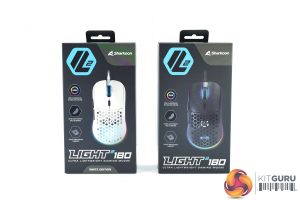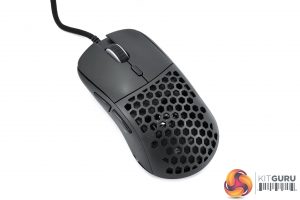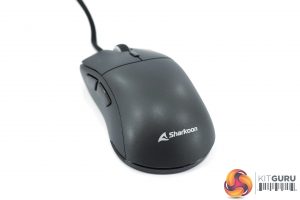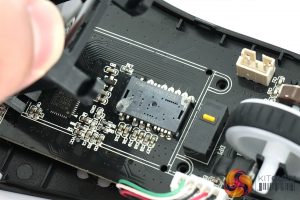The Sharkoon Light2 180 ships in a black box, with a large image of the mouse taking up most of the front side. On the back, three key features are highlighted in multi-lingual text.
Inside the box we find a quick-start guide, three spare mouse feet and the solid panel for the replaceable top shell section.
As you can see, the Light2 180 is available in both matte black and matte white, but for the purposes of this review, I'll be focusing on the black version (just because it is easier to photograph!)
Taking a closer look at the design of the mouse then, starting with the shape. It is clear to see that it has been heavily influenced by the Zowie S2 and I'd say calling it a ‘clone' is not inaccurate. That means it's a symmetrical shape (though not fully ambidextrous as it only has side buttons on the left), with the sides flaring out slightly towards the back, while the top of the mouse also raises to a hump about two thirds down the length of the shell.
Those side buttons are fairly prominent on the left-hand side, while the right-hand side is left bare. Incidentally, the entirety of the mouse is made from a smooth plastic, though we talk more about build quality and comfort on the next page.
At the front of the Light2 180 we get a look at the two separated primary buttons, along with the textured rubber scroll wheel. A single DPI button sits just behind the wheel.
And then on the underside, two large 100% PTFE feet are immediately obvious, while a third, much smaller pad sits around the sensor lens. The sensor itself is PixArt's PMW 3360 – a former flagship that has since been superseded by the PMW 3389 and PAW 3370. We can also note a three-step slider which lets user configure polling rate to 125Hz, 500Hz or 1000Hz.
Back to the top of the mouse though, it's worth showing the removable shell in more detail. Essentially, the back section of the top shell is completely removable, allowing users to choose between a solid panel or a perforated one. These interchangeable pieces attach to the main shell via small clips and is easily removable by lifting towards the back of the mouse.
The perforated panel is lighter, at 5g on my scales, while the solid option weighs in at 7g. I'm not sure if 2g will make any difference from a performance perspective, but it's certainly a nice touch from a visual standpoint.
As for the cable, this is a paracord-style design, measuring 1.8m long and terminating in a gold-plated USB Type-A connector.
Internally, there are a few areas of note. The first is the use of Omron D2FC-F-7N(20M) switches, the same as found in the Light2 200 and numerous other mice – though the use of Huano and even optical switches are becoming more and more popular.
Speaking of Huano, Huano yellow switches are used for both the side buttons and the DPI button. A Huano blue switch is used for the scroll wheel click, with the encoder manufactured by F-Switch.
Just like the Light2 200, a large piece of plastic, sporting the ‘L2 ‘ logo covers the middle of the PCB. We were previously told this was for both aesthetic reasons and also to prevent any dust or dirt getting into the sensor, as the sensor itself is directly underneath this plastic piece. As mentioned, PixArt's PMW 3360 is used.
 KitGuru KitGuru.net – Tech News | Hardware News | Hardware Reviews | IOS | Mobile | Gaming | Graphics Cards
KitGuru KitGuru.net – Tech News | Hardware News | Hardware Reviews | IOS | Mobile | Gaming | Graphics Cards






















